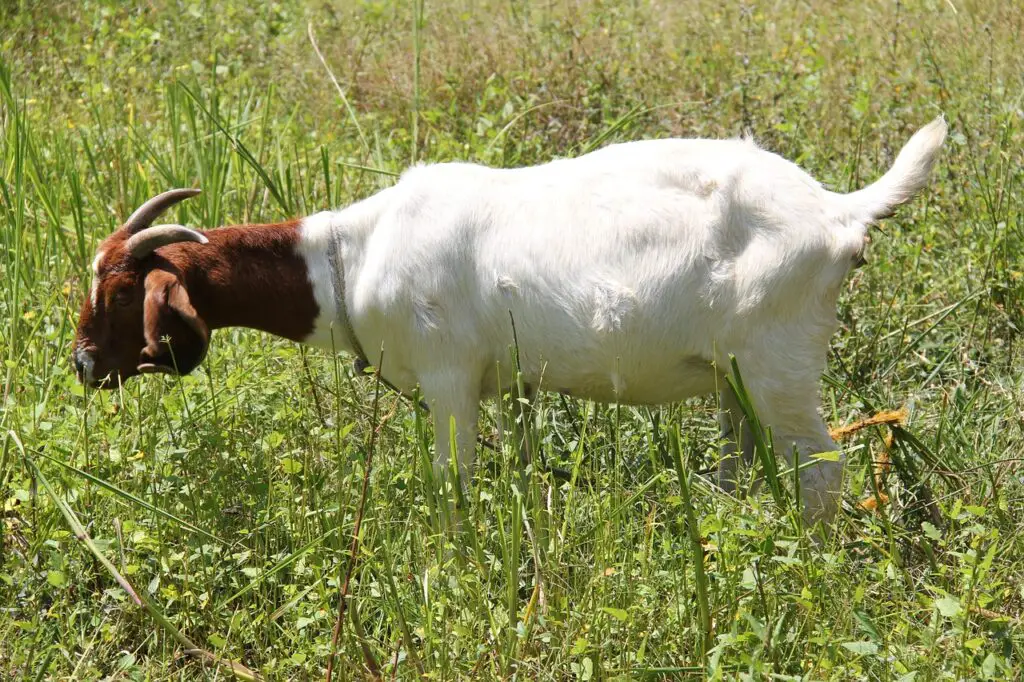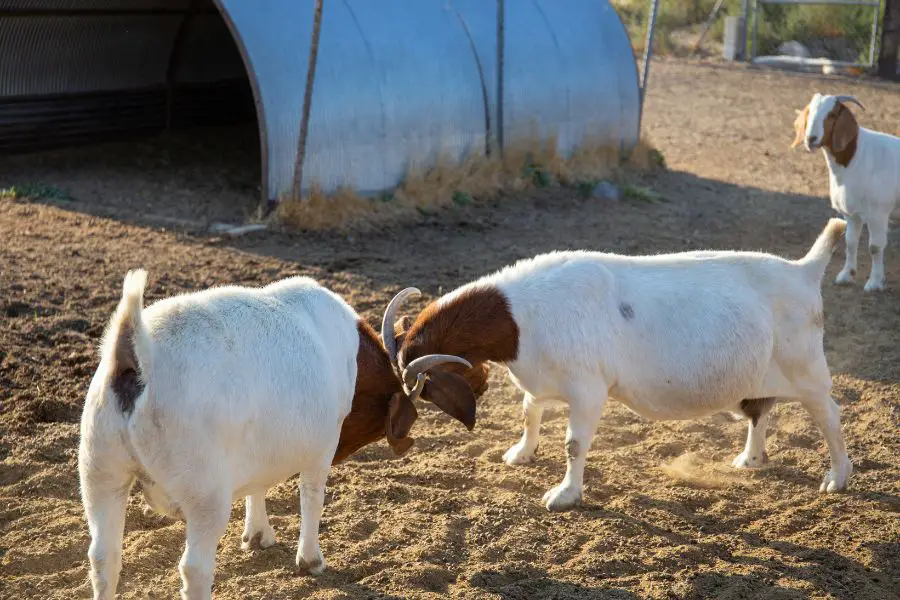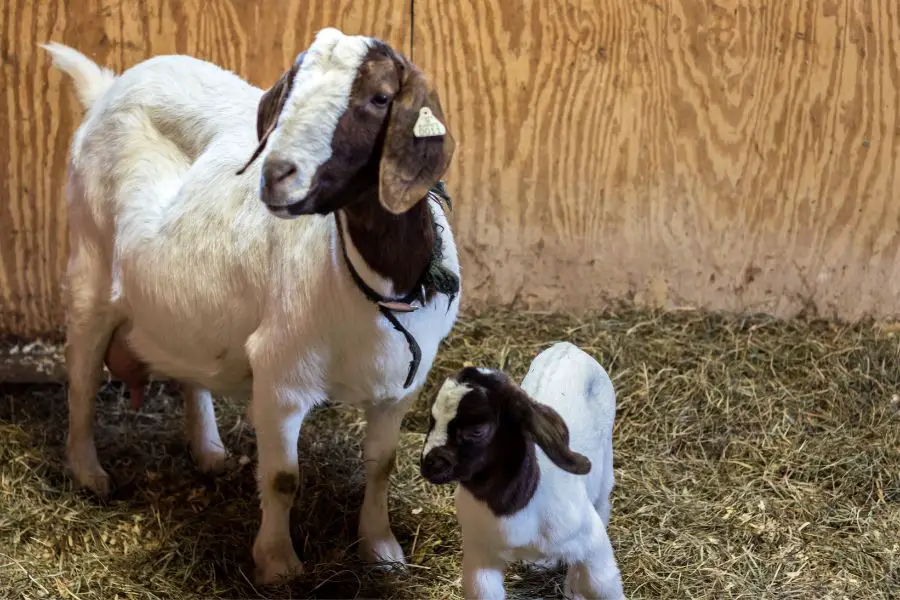The African Boer goat is arguably the best meat goat in the world. That, combined with its other fantastic characteristics, make this breed one of the most popular around the world.

In this article, we will cover everything you need to know about Boer goats. From their history to their health and other potential uses. There is a lot to cover, so let’s jump right into it.
Table of contents
African Boer Goat: Everything You Need to Know
As the name suggests, the African Boer goat hails from Africa – South Africa, in particular. As a result, the animal is also known as the South African Boer Goat. The breed was created via selective breeding (as all breeds are) across 70 years until the ultimate goat was created.
While the breed is originally from South Africa, they are now found all around the world, and are incredibly popular. Even so, breed standards are still set in South Africa to this day, and the animals there have the best genetics in the world.
A Brief History of the Boer Goat
It was only recently that Boer goats found their way to the United States – 1993! This quickly resulted in them becoming a very popular breed of meat goat.
From then on, the goat has remained popular for its meat-producing capabilities, and brings in significant money. There’s a lot more we could get into, but this is all you need to know!

Basic Information on Boer Goats
Scientific name – Capra aegagrus hircus
Country of origin – South Africa
Lifespan – 8–12 years (bucks) 12–20 years (does)
Size – 2.5 feet (30 inches) at the shoulder
Weight – 350 lbs (bucks) 190–250 lbs (does)
Coloring – usually white with brown coloring on their heads
What they are used for – meat goats
Boer Goat Characteristics
Boer goats are the heaviest goats in the world, and the bucks (males) can weigh up to 350 lbs (around 160 kg)! Females can reach weights of 250 lbs (113 kg), which is the same size as the largest males from other meat goat breeds (such as the Kalahari red). This alone makes these animals very impressive, and it’s no wonder they are popular because of their meat.
In terms of personality, these animals are very calm and docile. They are not aggressive in any way, and are unlikely to give you problems on the farm. Oddly enough, these characteristics also make them popular as companion animals. However, this role is typically taken by Nigerian dwarf and Pygmy goats, or other smaller breeds.
These goats grow very quickly, and have thick, curved horns that grow backwards. Generally, they do well in a variety of climates, and can adapt well. However, some farmers have encountered issues regarding parasites and pests when raised in arid climates (more on that later).
Dietary Needs of the Boer Goat
As you might expect, their large sizes mean that the African Boer goat does need to consume a lot of food to stay strong and healthy. Generally, you can expect one average goat to eat up to 4.4 lbs (2 kg) of hay every day. This number increases significantly when milking (up to 7 lbs). For Boer goats, this is likely to be even more.
You will typically feed your Boer goats 7 lbs of grain for every 1 lb you want them to gain. As such, somewhere between 1.75–2 lbs of grain every day will ensure that they gain around ¼ lb every day – a healthy amount.
Of course, they will also need to be provided with salt licks and other minerals they require in their diet.
Most Boer goats in their natural habitats will consume leaves, shrubs, and brush, but this will vary depending on where they are. They are also more than happy to enjoy fruit, vegetables, and various kitchen scraps. At least you don’t have to worry about them being fussy eaters!
Reproduction of Boer Goats
Like many other goats, Boer goats should be kidded up to three times every two years. They will typically produce three kids, and will nurse them for three months. As always, some goats may produce more kids, and some less.
Usually, there are steps you can take in an attempt to make each doe have more kids, but you need to be cautious with Boer goats. One of the standards for these goats is for the kids to weigh between 7.7–11 lbs at birth (3.5–5 kg). Kids that weigh 6.6 lbs (3 kg) or less are usually a sign of the doe having a deficiency.
Because of this, three kids is plenty! Leave your does to do their thing.
Their gestation period is roughly 150 days, so at the 5-month benchmark, you can expect to have kids frolicking around in no time.

Overall Health
Considering their overall health, Boer goats are very healthy and hardy animals. While this is the case when their genetics are top quality, some animals are at an increased risk of experiencing and suffering from internal parasites. This is especially the case in arid climates, so this is something to consider if you are planning on getting Boer goats.
It is useful to mention that because of how popular these goats are, they are frequently cross bred with other popular breeds. This includes breeds such as Osmanabadi, Kiko, Sirohi, Nubians, and Angoras. The good news is, these other goats are also excellent meat goats, and the offspring usually have all the best features you could ask for.
Fertility of These Goats
One major selling point on African Boer goats is their unmatched fertility. As this is one of the most important economic matters to consider when purchasing any livestock animal, this is a real win.
With good genetics and excellent management, you can easily deliver 180% kidding percentages. This is incredibly hard to beat, and you probably won’t find another livestock breed that can top this.
Once again, it is entirely possible to get quadruplets, or even more, from a single doe. However, the more kids a doe has, the smaller they should be. Not only that, but you want to consider the wellbeing of the doe, and not put too much stress on her. On top of that, it’s important to remind buyers that there is lots of additional management that goes into having more kids – something to remember!
Boer Goat Appearance and Size
African Boer goats are known for their impressive weights, and they have a large, stocky appearance. While they only measure around 2.5 feet (30 inches) at the shoulder, their bulk is what really pays off. We already mentioned how large they can get (350 lbs for adult bucks, and 250 lbs for adult does), but there are other features to be aware of.
In terms of color, they are almost always white, with a brown head and minimal other markings on them. Crossbreeding can, of course, result in different markings and colors. However, a purebred will always look similar and only be two colors. These animals also have large floppy ears, and sizable horns that grow backwards in a curve.

What Are Boer Goats Bred For?
We already mentioned that Boer goats are raised as meat goats, but let’s take a better look at their uses.
They are Excellent Meat Goats
Boer goats are known for their tender and juicy meat – and large quantities of it. In terms of flavor, the meat is known to be mild, with a pleasant flavor, and great for a variety of dishes.
Thanks to their large size, their meat yield is an impressive one, and one goat could feed a family for days. This makes them worth the money if you are thinking of farming them for their excellent meat production.
Can Boer Goats be Used for Milk?
Surprisingly, Boer goats can be a good option for milk, due to the fact that they have milk yield ancestry. These goats could supply up to 3 liters of milk every day – but this will depend on different factors. For the most part, you can expect the milk production of these goats to be somewhere between 1.5–2.5 liters of milk a day.
The milk produced by Boer goats is usually 6% fat. These animals will typically have a smaller milking window compared to other breeds, so this is another reason why they are not popular milk goats. However, you could make it work if you wanted to!
Video: Beautiful South African Boer Goat Farm
This short video highlights beautiful African Boer Goats on a lovely goat farm.
Final Thoughts
Boer goats are the best meat goats in the world thanks to their impressive sizes (males up to 350 lbs). They are friendly, docile, and gentle, too. The mothers are excellent at caring for their kids, and have a very high fertility rate, where you can easily deliver 180% kidding percentages with the right resources.
These factors combined with the hardiness of the animal, makes them an excellent option if you are looking to make some money with meat goats.




